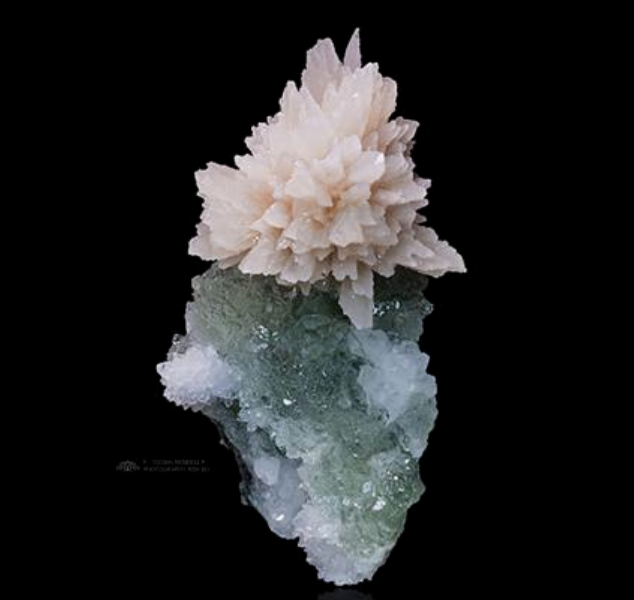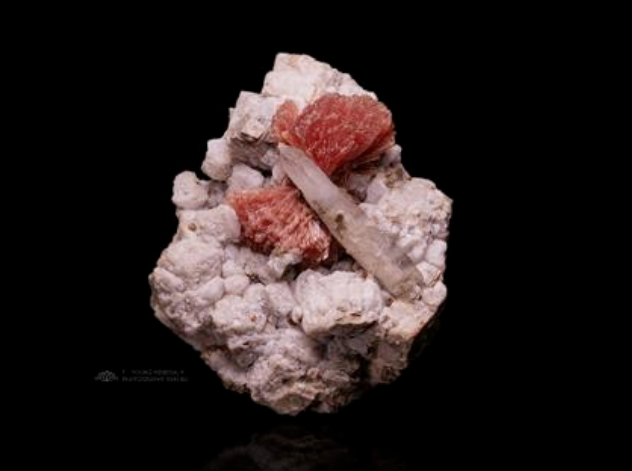Mineral crystal specimens on exhibit
2023-05-19
The flower of life
The Cruzeiro mine is one of the world’s most famous gemstone and mineral specimen sites.
It was extracted by manual labor instead of mechanical mining, making the process extremely difficult.
The mineral specimen is one of the largest rubellites currently found in the world, measuring 25cm in width, 46cm in height, and weighing 22.5 kilograms. The specimen is called the “Flower of Life” due to its red hue and its shape like a flower about to bloom. The Chaos Art Museum collected it in 2015, and it was first shown to the public at the China (Hunan) International Mineral and Gem Expo in 2016. It was later displayed as a significant exhibit at the Geological Museum of China.

Calcite with fluorite
Fluorite and calcite are both unique minerals in China, known for their variety of colors and crystal shapes. Even specimens from the same location can vary greatly. They are highly sought after by mineral enthusiasts both domestically and internationally. In addition, China annually supplies scores of fluorite and calcite specimens to the global mineral crystal market.
At the second CMGE in 2014, a miner was trying to hide a black wrapped box under the display case when a staff of Chaos Art Museum happened to pass by and see it. Out of curiosity, the museum staff asked the miner to show them the specimen inside. Initially hesitant, the miner eventually revealed a specimen of fluorite and calcite coexisting in the mineral. Seeing the yellow calcite and green fluorite in a flower formation coexisting in the golden ratio of 3/8, they were captivated by the natural beauty of the specimen. After several rounds of bidding with the miner, the Chaos Art Museum succeeded in adding the stunning specimen to its impressive collection.

Inesite with crystal and dolomite
During the mining process at Fengjiashan Mine, sporadic occurrences of rare minerals such as inesite and dolomite were found. However, the inesite specimens produced had normal colors and textures. It was until 2000 and 2001 that beautiful inesite specimens were discovered. These small crystals are typically about 5-10mm in size and often form dense clusters on the surface of small crystal caves, or in fan-shaped and spherical formations on top of crystal clusters.
The rarity and high quality of inesite from Fengjiashan Mine caused a stir in the global mineral collecting community, which led to the majority of inesite specimens being acquired by foreign collectors. This particular specimen is one of the highest-quality Fengjiashan inesite specimens known to be circulating among collectors outside of China.
In 2016, the Chaos Art Museum had the chance to view it among American collectors, and was enchanted by its immaculate shape and color. After several visits, the museum finally succeeded in bringing it back to China. It is one of the prestigious collections of the Chaos Art Museum.

Cassiterite with muscovite
With an altitude of 5,588 meters, Xuebaoding stands as the tallest peak in the Minshan Mountains and is among the highest peaks in Sichuan Province. Over time, frequent tectonic and magmatic activities have led to the formation of a polymetallic ore deposit within Xuebaoding, containing various metals such as tungsten, tin, copper, lead, and zinc.
Initially, it was possible to collect mineral specimens from the exposed quartz veins on the steep slopes of Xuebaoding. However, as it became more challenging to obtain specimens, surface mining with simple tools gave way to underground mining with mechanical excavation equipment.
Due to environmental protection regulations, all mining activities on Xuebaoding are currently prohibited. This makes the possession of a mineral specimen from Xuebaoding particularly rare and valuable. The folded structure of the muscovite crystals creates a more stereoscopic appearance, while the stacked crystal flakes form an attractive flower-like pattern. In addition, the coexistence of cassiterite further enhances the contrast within the specimen.




